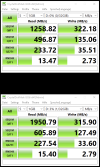Broadcom is here. I began exploring Proxmox + Ceph yesterday. Got a nested 3 node spun up and now diving into Ceph.
Does Ceph offer a protection scheme similar to VMware VSAN 2 host mirroring (Nested fault domains) ?
If not familiar - with VSAN 2/3 node cluster having 3 disk groups within a storage policy you can mirror data across 2 separate disks/groups + 2 hosts. Usable space does get a 3x overhead (100GB = 400GB) but makes data very available. Total host failure + disk group failure on remaining host. Its primarily for VSAN 2 nodes but know that Ceph wants minimum of 3 hosts.
Watching few videos thus far is appears Ceph model / crush rules is OSD or Host as protection strategy. But not both together.
I have not done much digging into Ceph yet but thought I'd ask if this is possible. Thanks.
Does Ceph offer a protection scheme similar to VMware VSAN 2 host mirroring (Nested fault domains) ?
If not familiar - with VSAN 2/3 node cluster having 3 disk groups within a storage policy you can mirror data across 2 separate disks/groups + 2 hosts. Usable space does get a 3x overhead (100GB = 400GB) but makes data very available. Total host failure + disk group failure on remaining host. Its primarily for VSAN 2 nodes but know that Ceph wants minimum of 3 hosts.
Watching few videos thus far is appears Ceph model / crush rules is OSD or Host as protection strategy. But not both together.
I have not done much digging into Ceph yet but thought I'd ask if this is possible. Thanks.


